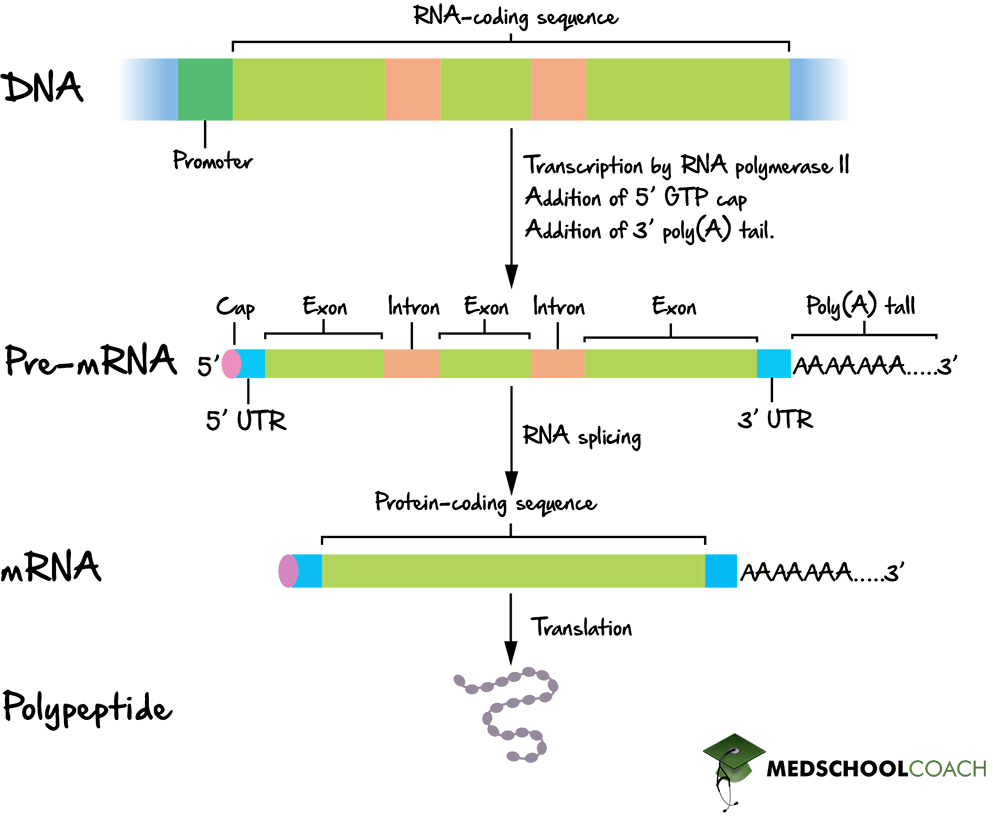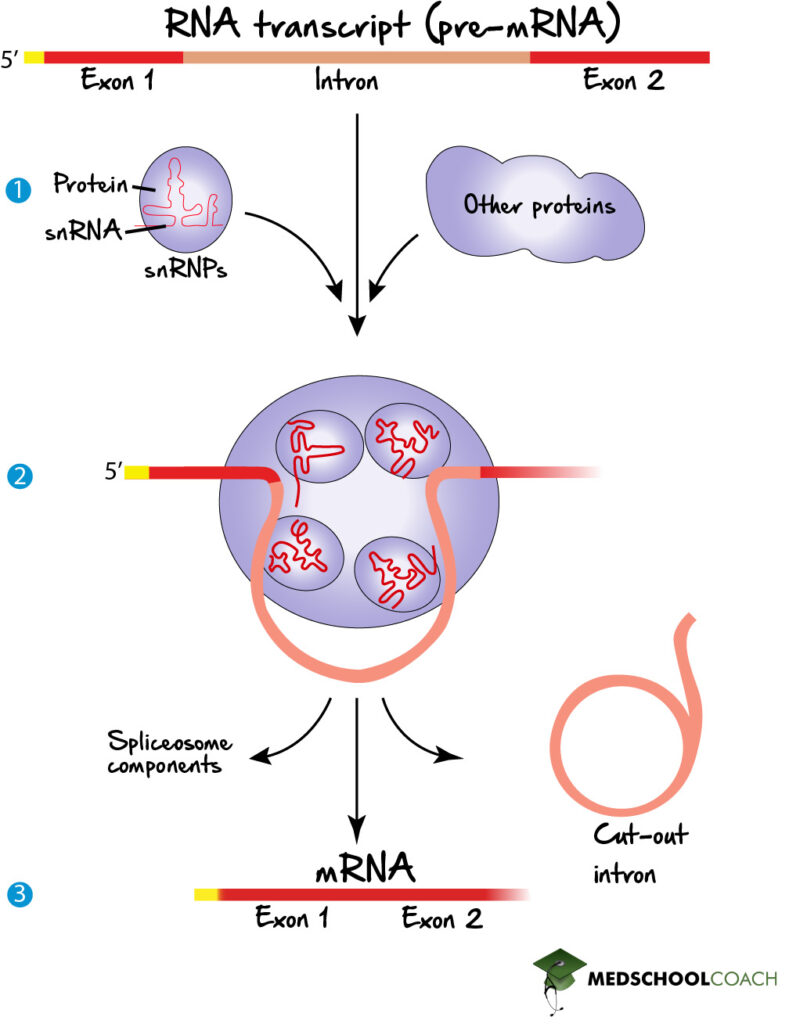Eukaryotic RNA Processing & Splicing
MCAT Biology - Chapter 2 - Section 1.3 - Gene Expression - Eukaryotic RNA Processing & Splicing
- Home
- »
- MCAT Masterclass
- »
- Biological and Biochemical Foundations of Living Systems
- »
- Biology
- »
- Eukaryotic RNA Processing & Splicing – MCAT Biology
Sample MCAT Question - Eukaryotic RNA Processing & Splicing
Which RNA modifications protect the RNA from degradation and promote translation?
a) The 5′ cap and splicing noncoding regions
b) Splicing coding regions and the poly-A tail
c) The poly-A tail and alternative splicing
d) The 5′ cap and the poly-A tail
D is correct.
There are three critical modifications in RNA processing – the addition of methylated guanine at the 5’ end of the RNA, polyadenylation at the 3’ end, and RNA splicing. The addition of the 5’ cap and poly-A tail at the 3’ end both protect the RNA from degradation by providing increased stability to the RNA molecule and help promote translation. Answer choices A, B and C are incorrect because splicing does not protect the RNA from degradation.
Get 1-on-1 MCAT Tutoring From a Specialist
With MCAT tutoring from MedSchoolCoach, we are committed to help you prepare, excel, and optimize your ideal score on the MCAT exam.
For each student we work with, we learn about their learning style, content knowledge, and goals. We match them with the most suitable tutor and conduct online sessions that make them feel as if they are in the classroom. Each session is recorded, plus with access to whiteboard notes. We focus on high-yield topics if you’re pressed for time. If you have more time or high-score goals, we meticulously cover the entire MCAT syllabus.
Eukaryotic mRNA Processing
The RNA molecule transcribed by RNA polymerase, will undergo several modifications before forming mature mRNA. These processes are referred to as eukaryotic mRNA processing. Note that these processes only happen in eukaryotes, not in prokaryotes. The original mRNA molecule that is produced by transcription is called pre-mRNA. Only once the pre-mRNA undergoes mRNA processing will it become mature mRNA. Eukaryotic mRNA processing occurs in the nucleus of the cell. In this way, any mRNA that has been released from the nucleus into the cytoplasm has already undergone these modifications.
Eukaryotic mRNA processing consists of three modifications to the RNA molecule: The addition of a 5’ cap, a 3’ poly-A tail, and RNA splicing (Figure 1).

mRNA 5' Capping and 3' Polyadenylation
The 5’ cap refers to the addition of a methyl-guanine at the 5’ end of the pre-mRNA. The poly-A tail refers to polyadenylation or the addition of a chain of adenosine molecules at the 3’ end of the pre-mRNA. The purpose of both these modifications is to protect the RNA from degradation and to promote translation. RNA is not a very stable molecule, so without these particular modifications, it would degrade easily and quickly. Since mRNA is to be translated into proteins, these modifications are vital to its stability and function.
Alternative mRNA Splicing
Another modification of eukaryotic mRNA processing is RNA splicing. The pre-mRNA molecule consists of both nucleotides that will code for the protein of interest and nucleotides that will not. Splicing is the process by which the noncoding regions, called introns, are spliced out or removed. When the introns are removed, what is left are the coding regions of RNA, known as exons.
RNA splicing does not occur in the same fashion every time, as the pre-mRNA molecule can be spliced in multiple ways. This variety in splicing is referred to as alternative splicing. Alternative splicing is essential because it creates a more efficient system of protein production. It is a process that allows for the formation of different versions of mature mRNA and, therefore, different protein products from only a single gene. Instead of needing new gene sequences to create different protein products, a single gene sequence is sufficient enough to create multiple protein products.
What is interesting to note is that alternative mRNA splicing has been shown to alter the diversity of certain diseases, such as cancer. While at first glance, this may seem problematic, researchers believe that the broader and more varied the cancer, the more targets for cancer immunotherapy. To date, the vast array of alternative splicing-derived cancer targets has been mainly unexplored. Perhaps they can offer an effective way to treat previously untreatable cancers.
Spliceosomes
The spliceosome is a very large RNA and protein complex located in the nucleus of the cell, which acts as the machinery used for RNA splicing. Each spliceosome complex is made up of several types of small nuclear RNA, or snRNA, and protein factors. The combination of the snRNA and protein factors create what are known as small nuclear ribonucleoproteins, or snRNPs. The snRNPs then bind to pre-mRNA molecules creating a new spliceosome complex.

Explore More MCAT Masterclass Chapters
Take a closer look at our entire MCAT Masterclass or explore our Biochemistry lessons below.

One-on-One Tutoring
Are you ready to take your MCAT performance to a whole new level? Work with our 99th-percentile MCAT tutors to boost your score by 12 points or more!
See if MCAT Tutoring can help me
Talk to our enrollment team about MCAT Tutoring

MCAT Go Audio Course
Engaging audio learning to take your MCAT learning on the go, any time, any where. You'll be on the way to a higher MCAT score no matter where you are. Listen to over 200+ lessons.

MCAT Practice Exams
Practice makes perfect! Our mock exams coupled with thorough explanations and in-depth analytics help students understand exactly where they stand.

MCAT Prep App
Access hundreds of MCAT videos to help you study and raise your exam score. Augment your learning with expert-created flashcards and a question banks.